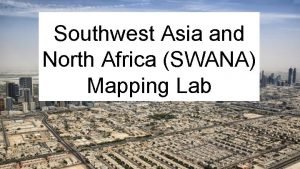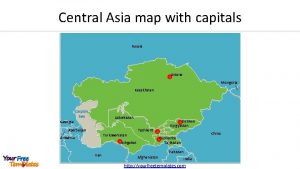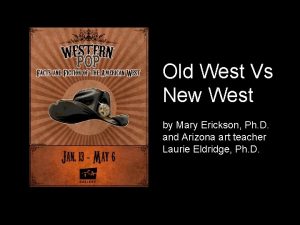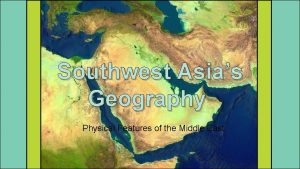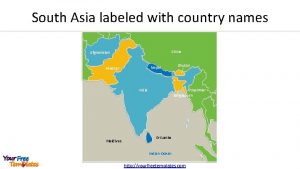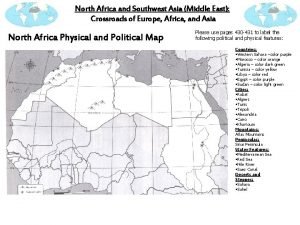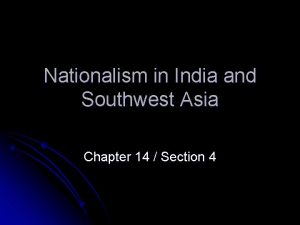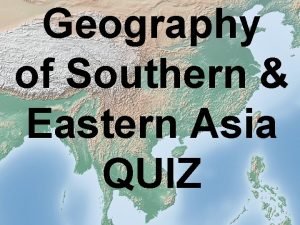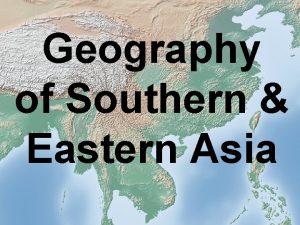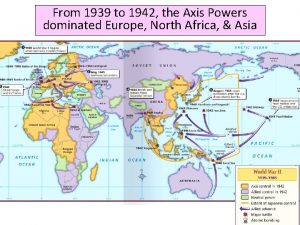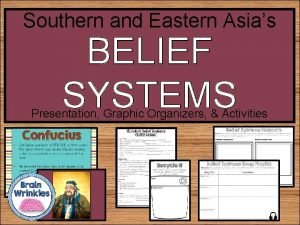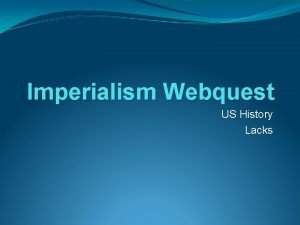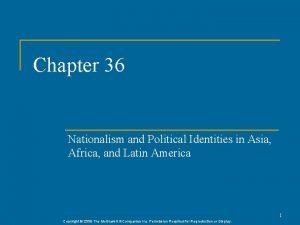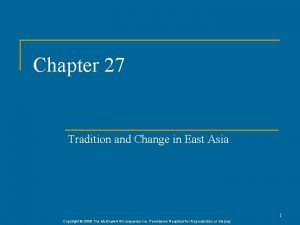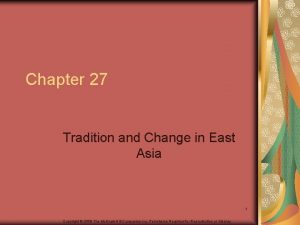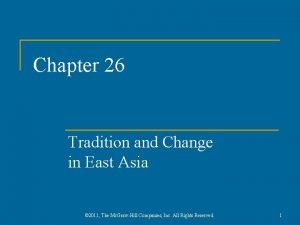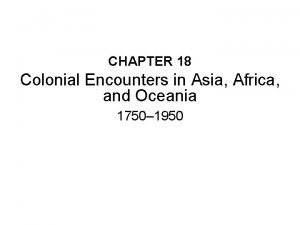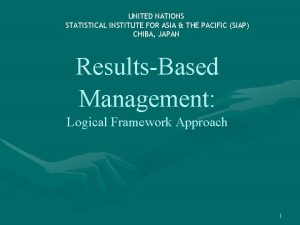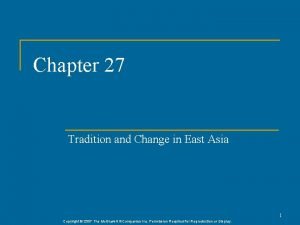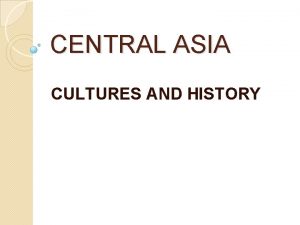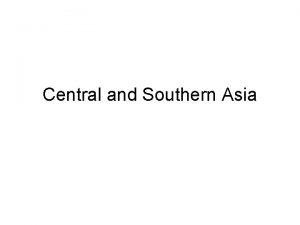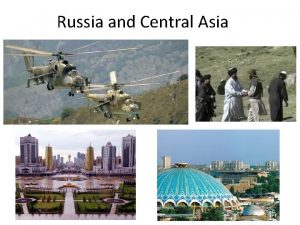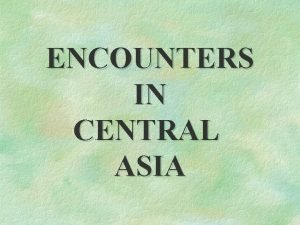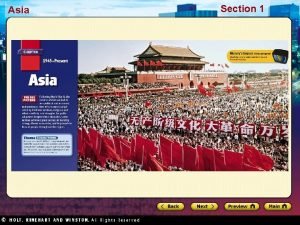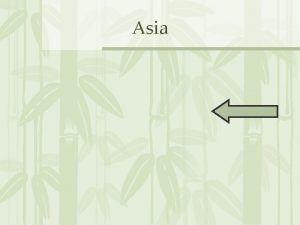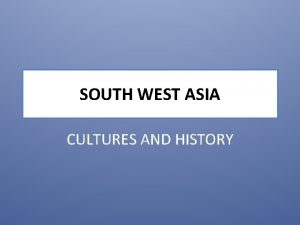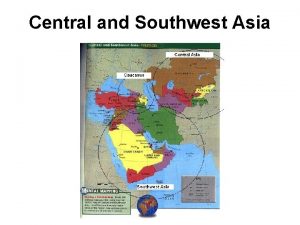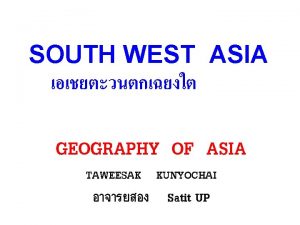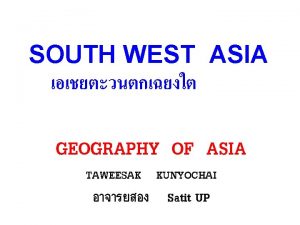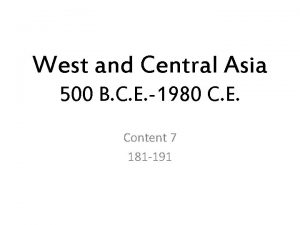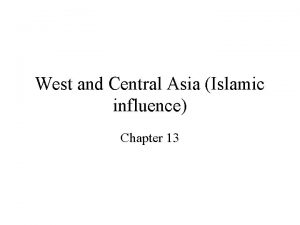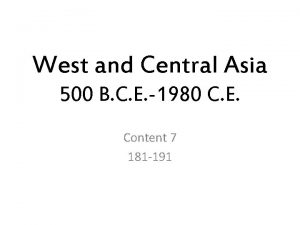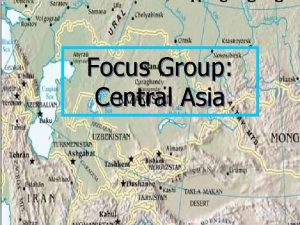WEST AND CENTRAL ASIA WEST CENTRAL ASIA West








































- Slides: 40

WEST AND CENTRAL ASIA WEST & CENTRAL ASIA

West & Central Asia Petra, Jordan and Great Temple, Nabataean Ptolemaic and Roman. c. 400 BCE – 100 CE. Cut rock. Petra is the most popular attractions in Jordan for tourists and also one of the world's most famous historical archeological sites. It is an ancient city located between the Dead Sea and the Red Sea. The city is half man-made and half carved into the rock and had a water conduit system that is also one of the reasons the city is famous. It is often referred to as the Rose City because of the rose color of the rock from which the city was carved. The Western world knew nothing of Petra until a Swiss explorer introduced it in 1812. The Greek word for ‘rock’, Petra was the center of caravan trade, an important junction for the silk trade. It was located at a junction that China, India, Egypt, Greece, Rome, Syria and southern Arabia used for trading spices and silk, among other products. WEST & CENTRAL ASIA

West & Central Asia Petra, Jordan and Great Temple, Nabataean Ptolemaic and Roman. c. 400 BCE – 100 CE. Cut rock. Based on the style of fragments found at the site, archaeologists believe the Great Temple was built in the last quarter of the 1 st century BC and further enlarged in the 1 st century AD. It continued to be used until the Byzantine period (5 th century). As its name indicates, the structure is generally assumed to be a temple; if so, it was probably dedicated to the principal deity of Petra, Dushara. But the discovery of a small theater or bouleuterion within the complex, combined with written records of a popular assembly in Petra during this period, leave open the possibility that it was a large palace and assembly hall. The temple remained hidden under dust and rubble until 1992, when it was rediscovered by Brown University archaeologists. Excavation and restoration work began in 1993 and continues today. WEST & CENTRAL ASIA

West & Central Asia Petra, Jordan – Treasury Nabataean Ptolemaic and Roman. c. 400 BCE – 100 CE. Cut rock. Perfectly positioned opposite the main route into Petra, the Treasury (al-Khazneh in Arabic) was designed to impress, and, two thousand years on, the effect is undiminished. What strikes you first is how well preserved it is; carved deep into the rockface and concealed in a high-walled ellipse of a valley (known as Wadi al-Jarra, “Urn Valley”), it has been protected from wind and rain from day one. The detailing of the capitals and pediments on the fortyby-thirty-metre facade is still crisp. It is normally dated to the first century BC, possibly to the reign of King Aretas III Philhellene (“the Greek-lover”), who brought architects to Petra from the centers of Hellenistic culture throughout the Mediterranean. WEST & CENTRAL ASIA

West & Central Asia Buddhist Art Buddha. Bamiyan, Afghanistan, Gandharan. c. 400 -800 BCE (destroyed in 2001 by Taliban). Cut rock with plaster and polychrome paint. The Buddhas of Bamiyan were two 6 th-century monumental statues of standing buddha carved into the side of a cliff in the Bamyan valley in the Hazarajat region of central Afghanistan. Built in 507 AD (smaller) and 554 AD (larger), the statues represented the classic blended style of Gandhara art. The main bodies were carved directly from the sandstone cliffs, but details were modeled in mud mixed with straw, coated with stucco. The lower parts of the statues' arms were constructed from the same mud-straw mix while supported on wooden armatures. It is believed that the upper parts of their faces were made from great wooden masks or casts. Rows of holes that can be seen in photographs were spaces that held wooden pegs that stabilized the outer stucco. They were dynamited and destroyed in March 2001 by the Taliban, on orders after the Taliban government declared that they were idols. WEST & CENTRAL ASIA

West & Central Asia Buddha in 1963 and in 2008 after its destruction WEST & CENTRAL ASIA

West & Central Asia Buddhist Art Jowo Rinpoche (enshrined in the Jokhang Temple). Lhasa, Tibet. Around 641 CE. Gilt metals with semiprecious stones, pearls, paint. Jokhang Temple ("House of the Lord") in Lhasa is the holiest site in Tibetan Buddhism, attracting crowds of prostrating Tibetan pilgrims and curious foreign tourists every year. It hosts the annual Great Prayer Festival, as well as all ceremonies of initiation for the Dalai Lama and Panchen Llamas. The Jowo Rinpoche is a statue that is housed inside of the temple, and is said to have been personally blessed by the Buddha. WEST & CENTRAL ASIA

West & Central Asia Johkang Temple, Tibet WEST & CENTRAL ASIA

West & Central Asia Johkang Temple, Tibet WEST & CENTRAL ASIA

West & Central Asia Islamic Art & Architecture Words to know: Arabesque Dome of the Rock Great Mosque of Cordoba Iwan Kufic Script Mihrab Minaret Mosque Reliquary Qibla Wall Taj Mahal WEST & CENTRAL ASIA

West & Central Asia Islamic Art & Architecture Islamic Art Islam is a monotheistic religion originating with the teachings of Muhammad, a 7 th century Arab religious and political figure. The word Islam means "submission", or the total surrender of oneself to God. A worshipper of Islam is known as a Muslim, meaning "one who submits (to God)". There are between 1. 1 billion and 1. 8 billion Muslims (19. 6%), making Islam the second-largest religion in the world, after Christianity (33%). WEST & CENTRAL ASIA

West & Central Asia Islamic Art & Architecture Islamic Art Muslims believe that God revealed the Qur'an to Muhammad, God's final prophet, and regard the Qur'an and the Sunnah (words and deeds of Muhammad) as the fundamental sources of Islam. They do not regard Muhammad as the founder of a new religion, but as the restorer of the original monotheistic faith of Abraham, Moses, Jesus, and other prophets. Islamic tradition holds that Jews and Christians distorted the revelations God gave to these prophets by either altering the text, introducing a false interpretation, or both. WEST & CENTRAL ASIA

West & Central Asia Islamic Art & Architecture Islamic Art Almost all Muslims belong to one of two major denominations, the Sunni and Shi'a. The separation developed in the late 7 th century following disagreements over the religious and political leadership of the Muslim community. Roughly 85 percent of Muslims are Sunni and 15 percent are Shi'a. Islam is the predominant religion throughout the Middle East, as well as in parts of Africa and Asia. Graffiti left inside Sunni mosque by Shi'ite militias, read "Wahhabis are the enemies of Iraq. " WEST & CENTRAL ASIA

West & Central Asia Islamic Art ? The Islamic Faith is based on the ‘Five Pillars’ of Islam: Shahādah - Profession of faith Salah – Prayer 5 times a day Zakâh - Giving to the poor Sawm - Fasting during Ramadan Hajj - Pilgrimage to Mecca Although Muslims believe that Jesus was a prophet, they reject the Christian doctrine of the Trinity, comparing it to polytheism. In Islamic theology, Jesus was just a man and not the son of God; God is described in a chapter of the Quar'an as "…God, the One and Only; God, the Eternal, Absolute; He begetteth not, nor is He begotten; And there is none like unto Him. " WEST & CENTRAL ASIA

West & Central Asia Jihad Most Muslims are peaceful people, but some Islamic groups throughout the World have used Jihad as a reason for violence instead of defense. Jihad means "to strive or struggle, " (. . in the way of God) and is considered the "sixth pillar of Islam" by a minority of Muslim authorities. Essentially Jihad is an effort to practice religion in the face of oppression and persecution. The effort may come in fighting the evil in your own heart, or in standing up to a dictator. Military effort is included as an option, but as a last resort and not "to spread Islam by the sword" as the stereotype would have one believe. Jihad also refers to one's striving to attain religious and moral perfection. Most Muslims today interpret Jihad as only a defensive form of warfare: the external Jihad includes a struggle to make the Islamic societies conform to the Islamic norms of justice. WEST & CENTRAL ASIA

West & Central Asia The Kaaba. Mecca, Saudi Arabia. 631 -632 CE. The Kaaba (or ‘The Cube’) is a small building in Mecca, Saudi Arabia, and is the most sacred site in Islam, The Qur'an states that the Kaaba was constructed by Abraham and his son Ishmael he had settled in Arabia. It is stated in the Qur'an that this was the first house that was built for humanity to worship Allah (God). It is the most sacred point within this most sacred mosque, making it the most sacred location in Islam. Wherever they are in the world, Muslims are expected to face the Kaaba – i. e. when outside Mecca, to face toward Mecca – when performing salat (prayers). Al-Masjid al-Haram was built around the Kaaba. From any point in the world, the direction facing the Kaaba is called the qibla. WEST & CENTRAL ASIA

West & Central Asia The Kaaba. Mecca, Saudi Arabia. 631 -632 CE. One of the Five Pillars of Islam requires every Muslim to perform the Hajj pilgrimage at least once in his or her lifetime if able to do so. Multiple parts of the Hajj require pilgrims to walk seven times around the Kaaba in a counter-clockwise direction. This circumambulation, the Tawaf, is also performed by pilgrims during the Umrah (lesser pilgrimage). However, the most difficult times are during the Hajj, when, about 6 million pilgrims gather to circle the building on the same day. WEST & CENTRAL ASIA

West & Central Asia WEST & CENTRAL ASIA

West & Central Asia Dome of the Rock The Dome of the Rock Jerusalem, Palestine. 691 -692. Stone masonry with glazed ceramic tile and bronze dome. The Dome of the Rock is an Islamic shrine (or reliquary) and a major landmark located on the Temple Mount in Jerusalem. It was completed in 691, making it the oldest existing Islamic building in the world. Muslims believe that Mohammed ascended to Heaven from the rock inside of this Dome. The building is only open to Muslims. Jews believe that it was on this rock that Abraham prepared to sacrifice Isaac, and this stone may have once stood in Solomon's Temple. Muslim tradition also has it that it an angel will appear here with a trumpet call to announce the Last Judgment at end of the world. WEST & CENTRAL ASIA

West & Central Asia Dome of the Rock This close-up photo of the lower exterior of the Dome of the Rock shows the magnificent tile work done by Suleiman the Magnificent in 1545. The arched niches used to contain mosaics, but they turned out to be too delicate for the harsh winters and Suleiman finally resolved the problem by replacing them all with tile. The Arabic inscription is of verses from the Qur'an. IMPORTANT NOTE!! In the Islamic religion, it is forbidden to worship other Gods… Islamic art takes this rule VERY seriously by forbidding images of animals or people (which could represent Gods) in their sacred buildings. For this reason, art of Islamic Holy places lacks figural representations. Instead, Islamic artists created elaborate abstract designs. WEST & CENTRAL ASIA

West & Central Asia Dome of the Rock WEST & CENTRAL ASIA

West & Central Asia Dome of the Rock Columns, arches and ambulatory inside the Dome. WEST & CENTRAL ASIA

West & Central Asia Islamic Art & Architecture Mihrab A mihrab is a niche in the wall of a mosque that indicates the qibla, that is, the direction of Mecca and hence the direction that Muslims should face when praying. The wall in which a mihrab appears is thus the "qibla wall. " Today, Mihrabs vary in size, are usually ornately decorated and often designed to give the impression of an arched doorway or a passage to Mecca. Sayings of the Prophet Muhammad are written in kufic script on the borders of the pointed arch of the niche. WEST & CENTRAL ASIA

West & Central Asia Islamic Art & Architecture Mihrab in Hagia Sophia, Istanbul. ISLAMIC ART WEST & CENTRAL ASIA

West & Central Asia Great Mosque (Isfahan, Iran) Great Mosque, Isfahan, Iran. c. 700 CE. Stone, brick, wood, plaster, glazed ceramic tile. Most cities with sizable Muslim populations possess a primary congregational mosque. These mosques are often expanded in conjunction with the growth and needs of the Muslim community; however, it is uncommon for such expansion and modification to continue over a span of a thousand years. The Great Mosque of Isfahan in Iran is unique in this regard and thus enjoys a special place in the history of Islamic architecture. Its present configuration is the sum of building and decorating activities carried out from the 8 th through the 20 th centuries. It is an architectural documentary, visually embodying the political exigencies and aesthetic tastes of the great Islamic empires of Persia. WEST & CENTRAL ASIA

West & Central Asia Great Mosque (Isfahan, Iran) View of the south iwan from the prayer hall WEST & CENTRAL ASIA

West & Central Asia Great Mosque (Isfahan, Iran) WEST & CENTRAL ASIA

West & Central Asia Great Mosque (Isfahan, Iran) WEST & CENTRAL ASIA

West & Central Asia Oljeitu chamber (prayer room with mihrab) WEST & CENTRAL ASIA

West & Central Asia Folio from a Qur’an. 8 th to 9 th Century CE. Ink, color, and gold on parchment. The Qur'an is the sacred text of Islam, consisting of the divine revelation to the Prophet Muhammad in Arabic. Over the course of the first century and a half of Islam, the form of the manuscript was adapted to suit the dignity and splendor of this divine revelation. However, the word Qur'an, which means “recitation, ” suggests that manuscripts were of secondary importance to oral tradition. In fact, the 114 suras (or chapters) of the Qur'an were compiled into a textual format, organized from longest to shortest, only after the death of Muhammad, although scholars still debate exactly when this might have occurred. WEST & CENTRAL ASIA

West & Central Asia Folio from a Qur’an (detail). 8 th to 9 th Century CE. Ink, color, and gold on parchment. Because figural imagery such as human or animal forms was considered inappropriate for the ornamentation of sacred monuments and objects, artists relied on vegetal and geometric motifs when they decorated mosques and sacred manuscripts. Vines and palmettes like the ones that surround the sura heading here appear alone in sacred contexts, but they also accompanied animal and human forms in the secular decoration of palaces and textiles. WEST & CENTRAL ASIA

West & Central Asia Basin (Baptistere de St. Louis). c 13201340 CE. Brass inlaid with gold and silver. The Mamluks were a group of warrior slaves who took control of several Muslim states and established a dynasty that ruled Egypt and Syria from 1250 until the Ottoman conquest in 1517. Master metal craftsman Mohammed ibn al-Zain created this brass basin during the Bahri Mamluk reign (1250– 1382). Inlaid with silver and gold, the basin’s wide central, outer band depicts a finely crafted procession of Mamluk emirs, or officials, among them a mace -bearer, ax-bearer, and bow-bearer. Four horsemen in roundels at the end of the procession of dignitaries may be personifications of different aspects of “horsemanship. ” Friezes of animals and coatsof-arms frame this exterior band decorate the basin’s interior as well. WEST & CENTRAL ASIA

West & Central Asia Basin (Baptistere de St. Louis). c 13201340 CE. Brass inlaid with gold and silver. The basin is an example of an object produced for one ceremonial context but later appropriated for another. It was probably commissioned by a wealthy Mamluk patron to serve as a banqueting piece or, alternately, as a vessel for ceremonial hand washing. Ultimately, however, it ended up in France, where it was used from at least the seventeenth century in the baptisms of children born to the French royal family. The various coats-of-arms on the basin were later worked over with fleur-de-lis, a motif that might have appealed to both the basin’s original Islamic and later European owners. The flower was a popular Mamluk emblem in the thirteenth and fourteenth centuries as well as a heraldic device of the French royal family. WEST & CENTRAL ASIA

West & Central Asia Bahram Gur Fights the Karg, folio from the Great il-Khanid Shahnama. Islamic, Perisan. C. 1330 -1340 CE. Ink, watercolor, gold and silver on paper. This folio is from a celebrated copy of the text known as the Great Ilkhanid Shahnama, one of the most complex masterpieces of Persian art. Because of its lavish production, it is assumed to have been commissioned by a high-ranking member of the Ilkhanid court and produced at the court scriptorium. The 57 surviving illustrations reflect the intense interest in the histories and experimental approach to painting of the Ilkhanid period (1256– 1335). The eclectic paintings reveal the variety of people in the Ilkhanid court in Tabriz, included merchants, missionaries, and diplomats from as far away as Europe and China. Here the Iranian king Bahram Gur wears a robe made of European fabric to slay a fearsome horned wolf in a setting marked by the conventions of Chinese landscape painting. WEST & CENTRAL ASIA

West & Central Asia Gayumars and Shahnama The Court of Gayumars, folio from Shah Tahmasp’s Shahnama. c. 1522 -1525 CE. Ink, watercolor, gold on paper. Gayumars was the legendary first king of Iran, associated with the beginning of civilization and an organized social order. He and his people lived in the mountains and wore clothes made of leopard skins. The court was prosperous and his subjects content: animals and humans alike obeyed the king, who was blessed with divine power. Gayumars had a son, Siyamak, whom he adored and who was loved by all. WEST & CENTRAL ASIA

West & Central Asia Gayumars and Shahnama The Court of Gayumars, folio from Shah Tahmasp’s Shahnama. c. 1522 -1525 CE. Ink, watercolor, gold on paper. Gayumars is seen sitting atop his mountain before a backdrop of flowering trees placed against a gilded sky. He looks down mournfully at his son, Siyamak, who will be killed in battle with the Black Div. Beneath him his courtiers stand organized in a circular manner around a center of luxuriant vegetation. The Shahnama ("The Book of Kings") is a long epic poem written by the Persian poet Ferdowsi between c. 977 -1010 CE and is the national epic of Greater Iran. Consisting of some 60, 000 verses, the Shahnama is the world's longest epic poetry written by a single poet. It tells mainly the mythical and to some extent the historical past of the Persian empire from the creation of the world until the Islamic conquest of Persia in the 7 th century. Countries in this region (Iran, Afghanistan, Georgia, Armenia, etc. ) celebrate this national epic. WEST & CENTRAL ASIA

West & Central Asia The Ardabil Carpet. Maqsud of Kashan. 1530 -1540 CE. Silk on wool. The Ardabil Carpet (which is actually a pair of carpets), is the world's oldest dated carpet and one of the largest, most beautiful and historically important in the world. Carpets are among the most fundamental of Islamic arts. Portable, typically made of silk and wools, carpets were traded and sold across the Islamic lands and beyond its boundaries to Europe and China. Those from Iran were highly prized. Carpets decorated the floors of mosques, shrines and homes, but they could also be hung on walls of houses to preserve warmth in the winter. The rich geometric patterns, vegetative scrolls, floral flourishes, so typical of Islamic art, are clearly evident in this remarkable carpet, encouraging the viewer to walk around, trying to absorb every detail of design. WEST & CENTRAL ASIA

West & Central Asia The Ardabil Carpet. Maqsud of Kashan. 1530 -1540 CE. Silk on wool. The completion of the carpets was marked by a four-line inscription placed at one end. The first three lines of poetry reads: Except for thy threshold, there is no refuge for me in all the world. Except for this door there is no resting-place for my head. The work of the slave of the portal, Maqsud Kashani. Maqsud was probably the court official charged with producing the carpets. By referring to himself as a slave, he may be presenting himself as a humble servant. WEST & CENTRAL ASIA

West & Central Asia The Ardabil Carpet. Maqsud of Kashan. 1530 -1540 CE. Silk on wool. WEST & CENTRAL ASIA

West & Central Asia Ardabil Carpet on display in London WEST & CENTRAL ASIA
 South west asia and north africa map
South west asia and north africa map Swana map
Swana map South west asia
South west asia Astana russia map
Astana russia map Conqueror of central asia
Conqueror of central asia East is east and west is west
East is east and west is west Horizontal movement of air is called
Horizontal movement of air is called What creates wind
What creates wind Noord oost zuid west kaart nederland
Noord oost zuid west kaart nederland Old west vs new west
Old west vs new west East west central
East west central Comparison chart romeo and juliet vs. west side story
Comparison chart romeo and juliet vs. west side story Physical features in the middle east
Physical features in the middle east Southern and eastern asia map
Southern and eastern asia map Se asia geography cloze notes 1
Se asia geography cloze notes 1 Insular and mainland southeast asia
Insular and mainland southeast asia South asia map and capitals
South asia map and capitals North africa and southwest asia physical map
North africa and southwest asia physical map Nationalism in india and southwest asia
Nationalism in india and southwest asia Southern and eastern asia physical features answer key
Southern and eastern asia physical features answer key Physical features of southern and eastern asia
Physical features of southern and eastern asia Goodguysww.
Goodguysww. Chapter 35 nationalism and political identities in asia
Chapter 35 nationalism and political identities in asia Inlet of indian ocean between africa and asia
Inlet of indian ocean between africa and asia University mobility in asia and the pacific
University mobility in asia and the pacific Islam vs. christianity venn diagram
Islam vs. christianity venn diagram Brain wrinkles southern and eastern asia
Brain wrinkles southern and eastern asia Brain wrinkles southern and eastern asia
Brain wrinkles southern and eastern asia Of vietnam
Of vietnam Scramble for africa webquest
Scramble for africa webquest Colonial encounters in asia africa and oceania
Colonial encounters in asia africa and oceania Chapter 36 nationalism and political identities in asia
Chapter 36 nationalism and political identities in asia Chapter 27 tradition and change in east asia
Chapter 27 tradition and change in east asia Chapter 27 tradition and change in east asia
Chapter 27 tradition and change in east asia Chapter 26 tradition and change in east asia
Chapter 26 tradition and change in east asia Chapter 18 colonial encounters in asia and africa
Chapter 18 colonial encounters in asia and africa Country uniting africa and sw asia
Country uniting africa and sw asia Asia africa north and south america
Asia africa north and south america Statistical institute for asia and the pacific
Statistical institute for asia and the pacific Chapter 27 tradition and change in east asia
Chapter 27 tradition and change in east asia North africa and southwest asia physical geography
North africa and southwest asia physical geography

